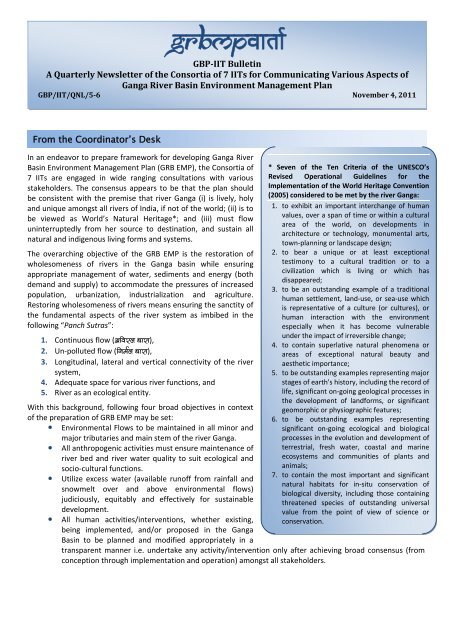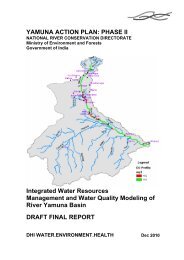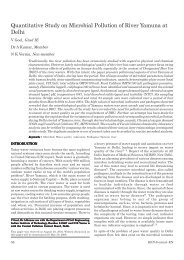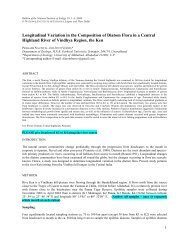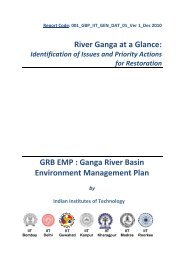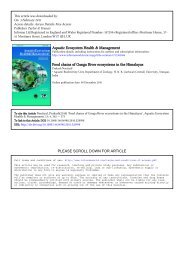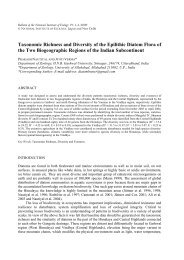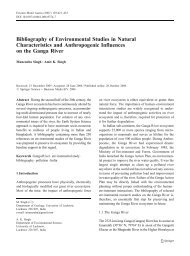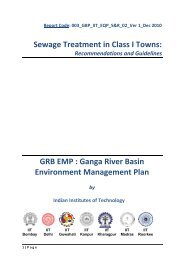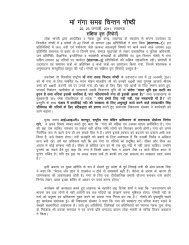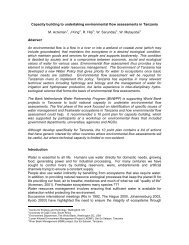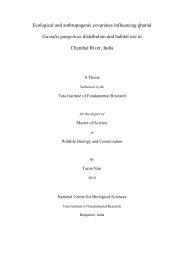GRBMP 2nd Newsletter_Final.pdf - GANGAPEDIA
GRBMP 2nd Newsletter_Final.pdf - GANGAPEDIA
GRBMP 2nd Newsletter_Final.pdf - GANGAPEDIA
Create successful ePaper yourself
Turn your PDF publications into a flip-book with our unique Google optimized e-Paper software.
From the Coordinator’s Desk<br />
Grbmpvaataa-<br />
GBPIIT Bulletin<br />
A Quarterly <strong>Newsletter</strong> of the Consortia of 7 IITs for Communicating Various Aspects of<br />
Ganga River Basin Environment Management Plan<br />
GBP/IIT/QNL/56 November 4, 2011<br />
In an endeavor to prepare framework for developing Ganga River<br />
Basin Environment Management Plan (GRB EMP), the Consortia of<br />
7 IITs are engaged in wide ranging consultations with various<br />
stakeholders. The consensus appears to be that the plan should<br />
be consistent with the premise that river Ganga (i) is lively, holy<br />
and unique amongst all rivers of India, if not of the world; (ii) is to<br />
be viewed as World’s Natural Heritage*; and (iii) must flow<br />
uninterruptedly from her source to destination, and sustain all<br />
natural and indigenous living forms and systems.<br />
The overarching objective of the GRB EMP is the restoration of<br />
wholesomeness of rivers in the Ganga basin while ensuring<br />
appropriate management of water, sediments and energy (both<br />
demand and supply) to accommodate the pressures of increased<br />
population, urbanization, industrialization and agriculture.<br />
Restoring wholesomeness of rivers means ensuring the sanctity of<br />
the fundamental aspects of the river system as imbibed in the<br />
following “Panch Sutras”:<br />
1. Continuous flow (Aivarla Qaara),<br />
2. Un‐polluted flow (inama-la Qaara),<br />
3. Longitudinal, lateral and vertical connectivity of the river<br />
system,<br />
4. Adequate space for various river functions, and<br />
5. River as an ecological entity.<br />
With this background, following four broad objectives in context<br />
of the preparation of GRB EMP may be set:<br />
Environmental Flows to be maintained in all minor and<br />
major tributaries and main stem of the river Ganga.<br />
All anthropogenic activities must ensure maintenance of<br />
river bed and river water quality to suit ecological and<br />
socio‐cultural functions.<br />
Utilize excess water (available runoff from rainfall and<br />
snowmelt over and above environmental flows)<br />
judiciously, equitably and effectively for sustainable<br />
development.<br />
All human activities/interventions, whether existing,<br />
being implemented, and/or proposed in the Ganga<br />
Basin to be planned and modified appropriately in a<br />
* Seven of the Ten Criteria of the UNESCO’s<br />
Revised Operational Guidelines for the<br />
Implementation of the World Heritage Convention<br />
(2005) considered to be met by the river Ganga:<br />
1. to exhibit an important interchange of human<br />
values, over a span of time or within a cultural<br />
area of the world, on developments in<br />
architecture or technology, monumental arts,<br />
town‐planning or landscape design;<br />
2. to bear a unique or at least exceptional<br />
testimony to a cultural tradition or to a<br />
civilization which is living or which has<br />
disappeared;<br />
3. to be an outstanding example of a traditional<br />
human settlement, land‐use, or sea‐use which<br />
is representative of a culture (or cultures), or<br />
human interaction with the environment<br />
especially when it has become vulnerable<br />
under the impact of irreversible change;<br />
4. to contain superlative natural phenomena or<br />
areas of exceptional natural beauty and<br />
aesthetic importance;<br />
5. to be outstanding examples representing major<br />
stages of earth's history, including the record of<br />
life, significant on‐going geological processes in<br />
the development of landforms, or significant<br />
geomorphic or physiographic features;<br />
6. to be outstanding examples representing<br />
significant on‐going ecological and biological<br />
processes in the evolution and development of<br />
terrestrial, fresh water, coastal and marine<br />
ecosystems and communities of plants and<br />
animals;<br />
7. to contain the most important and significant<br />
natural habitats for in‐situ conservation of<br />
biological diversity, including those containing<br />
threatened species of outstanding universal<br />
value from the point of view of science or<br />
conservation.<br />
transparent manner i.e. undertake any activity/intervention only after achieving broad consensus (from<br />
conception through implementation and operation) amongst all stakeholders.
In orrder<br />
to achieeve<br />
the abovve<br />
mentionedd<br />
objectives, , following pr rinciples andd<br />
criteria mayy<br />
be adopted d:<br />
Apply modern scieence<br />
and neww<br />
technologiies<br />
but with traditional wwisdom<br />
(&aana Qaara + jana &aan na).<br />
Precauutionary<br />
Prinnciples<br />
must apply whereever<br />
knowled dge gaps andd<br />
uncertaintiies<br />
exist.<br />
Multi‐ ‐disciplinary inputs needded,<br />
but neeed<br />
to be ca autious abouut<br />
only “Expperts”<br />
and “Some “ Influeential<br />
Stakehholders”<br />
drivving<br />
the proccess.<br />
Processs<br />
should ideeally<br />
start frrom<br />
smaller watersheds and build up<br />
in a nested<br />
manner to o the higher sub‐<br />
basin level, and thhen<br />
to the baasin<br />
level.<br />
Keep fflexibility<br />
to cater to futuure<br />
needs and<br />
changing contexts. c<br />
Clearlyy<br />
articulate choices andd<br />
the trade‐off<br />
involved d – Environmental<br />
Flowws,<br />
Irrigation n, Hydro poower,<br />
Domestic,<br />
Commeercial<br />
and Industrial<br />
neeeds<br />
or in oth her words Ennvironmental,<br />
Social, Cultural,<br />
Econoomic,<br />
and Financial<br />
criteeria<br />
must be given appropriate<br />
weigh htages.<br />
Need to treat parrts/portions<br />
of basin with<br />
heavy inte erventions (hhighly<br />
altered/modified)<br />
differently from<br />
portioons<br />
with low interventionn<br />
intensity (nnear<br />
pristine) ).<br />
Avoidiing<br />
and eliminating<br />
polluution<br />
through<br />
all direct and a visible annthropogenicc<br />
activities (z zero tolerancce<br />
or<br />
concept<br />
of zero discharge).<br />
Considder<br />
surface and groundd<br />
water toggether;<br />
Explore<br />
all posssible<br />
meanss<br />
of storing g water keeeping<br />
continnuous<br />
flow, aand<br />
longitudinal,<br />
lateral aand<br />
vertical connectivity c of the riverss.<br />
Existinng<br />
water usees<br />
to be proteected<br />
but care<br />
taken that<br />
existing ineequities<br />
are nnot<br />
perpetua ated.<br />
Creating<br />
broad puublic<br />
acceptance<br />
of the pplan<br />
(local bo odies, state aassemblies<br />
and<br />
parliament<br />
to debatee<br />
and<br />
approve).<br />
Creation<br />
of structuures<br />
to monitor<br />
and regulate<br />
the im mplementatioon<br />
(nested governance;<br />
central c and sstate<br />
governnment<br />
to serve<br />
as mentoor<br />
and local communitie es assigned rroles,<br />
responnsibilities<br />
and d rights on wwater<br />
considdering<br />
comprromises<br />
by/nneeds<br />
of upsstream/downstream<br />
commmunities.<br />
A river basin may be viewwed<br />
and mo odeled as a ttree<br />
(e.g. Baanyan<br />
Trree<br />
as showwn<br />
in the addjacent<br />
pictu ure) having numerous leeaves<br />
(reepresenting<br />
numerous watersheds) ) and many small and large<br />
brranches<br />
(representing<br />
small st treams/minoor<br />
and mmajor<br />
tributaries).<br />
Itt<br />
is important<br />
to realize that t health oof<br />
each and eevery<br />
watershed<br />
is paramountt<br />
to the ma aintenance oof<br />
the healtth<br />
of<br />
streams/<br />
tribuutaries,<br />
as aalso<br />
the health<br />
of the mmain<br />
stem oof<br />
the<br />
rivver<br />
in the bbasin.<br />
Hencee<br />
a bottom‐up<br />
approacch<br />
of conseerving<br />
watersheds,<br />
sstreams<br />
andd<br />
tributaries, , and wetlands<br />
to the main<br />
stem<br />
of the rivver<br />
is essential.<br />
While<br />
in terms oof<br />
actions ceertain<br />
issues (e.g. pollution),<br />
stretche es (e.g. mostt<br />
polluted sttretches),<br />
are eas or parts (e.g.<br />
mosst<br />
sensitive and<br />
fragile Gaangotri<br />
Valleey<br />
or some wwetlands)<br />
ma ay be addresssed<br />
on priorrity<br />
dependin ng upon urgeency,<br />
availability<br />
of reesources<br />
(e.gg.<br />
data and information)<br />
and time required r to ccomplete,<br />
annd<br />
integrate e upwards too<br />
the<br />
basin<br />
level (parts<br />
to the whole<br />
conceppt),<br />
the thouught<br />
process s has to be the other wway,<br />
i.e. who ole to the pparts.<br />
Simiilarly,<br />
GRB EMMP<br />
should bbe<br />
prepared based on souund<br />
scientific<br />
principles aand<br />
with appplication<br />
of modern/stat<br />
m te‐of‐<br />
the‐ ‐art tools, tecchniques<br />
andd<br />
methods bbut<br />
with tradditional<br />
know wledge and bbeliefs<br />
(e.g. ssubtle<br />
quality y of Ganga wwater<br />
as expressed<br />
thrrough<br />
followwing<br />
“Shloka” ” may also haave<br />
to be giv ven due conssideration).<br />
Asyaaa<br />
jalsya gauNaaa<br />
: SaItatvama\, ssvaadutvama,<br />
sva vaCtvama, Atyanntar}cyatvama\<br />
, paqtatvama\,<br />
paavanatvama\ ma\, paapahairtvamma\,<br />
taRYNaamaaohQQvaMsatvama\,<br />
dIp panatvama\, pa`&aaQQaairtvaMca,<br />
[it ita rajainaV-NaT T :<br />
TThe<br />
qualities oof<br />
the Ganga wwater<br />
are: Cooolness,<br />
sweetnness,<br />
transpar rency, high tonic<br />
property, wholesomene ess, potability, , ability<br />
to remove evils, ability tto<br />
resuscitate ffrom<br />
swoon ccaused<br />
by deh hydration, digeestive<br />
propertty<br />
and ability to t retain wisddom<br />
The use of tradittional<br />
knowledge/beliefss<br />
and precauutionary<br />
principle<br />
thus may<br />
imply thaat<br />
due consid deration be ggiven<br />
to thhe<br />
subtle quuality<br />
of Gannga<br />
water annd<br />
scientific efforts shou uld continuee<br />
to further uunderstanding<br />
on traditional<br />
knowwledge<br />
and bbeliefs.<br />
The policy frameework<br />
propoosed<br />
as abovve<br />
for preparring<br />
GRB EMP<br />
needs to bbe<br />
discussed at several fo orums by various<br />
stakkeholders.<br />
Feeedback,<br />
suggestions<br />
andd<br />
comments will be highl ly appreciateed.<br />
Vinod<br />
Tare, Profe fessor, IIT Kaanpur
Uppdates<br />
<strong>GRBMP</strong>P<br />
is now GRRB<br />
EMP: On the advice oof<br />
Shri Jairam m Ramesh, tthe<br />
then Minister<br />
of Sta ate (Indepenndent<br />
Charge)<br />
of the MoEF,<br />
the Gangga<br />
River Bassin<br />
Managem ment Plan (G<strong>GRBMP</strong>)<br />
has been referr red as the Ganga<br />
River Basin<br />
Environnment<br />
Managgement<br />
Plann<br />
(GRB EMP) since July 7, 2011.<br />
Geo‐sppatial<br />
Databaase<br />
Managemment<br />
(GDM) , one of the thematic grroups<br />
of GRBB<br />
EMP has re ecently launched<br />
its ownn<br />
website (wwww.gangalaaya.in;<br />
can aalso<br />
be acce essed througgh<br />
www.ganngapedia.in)<br />
to provide data<br />
storagee,<br />
retrieval, visualization<br />
and searcch<br />
capabilities<br />
along wwith<br />
relevant<br />
interfaces s for simulaation,<br />
predicttion<br />
and anaalysis<br />
of dataa<br />
for use of all thematic c groups andd<br />
policy makkers<br />
associated<br />
with the GRB<br />
EMP.<br />
Thhematic<br />
GGroup<br />
Actiivities<br />
Enviironmental<br />
QQuality<br />
and Pollution (EQQP):<br />
The EQP Groupp<br />
is involved<br />
in collectting<br />
and analyzing<br />
som me primary and mostly secondary data relateed<br />
to<br />
population,<br />
watter<br />
supply, sewage generation,<br />
coollection<br />
and<br />
treatment,<br />
status annd<br />
performa ance of sewwage<br />
treatment<br />
plantts<br />
(STPs) in the<br />
class I annd<br />
II cities/toowns<br />
in the entire Gangga<br />
River Basin<br />
for estima ation of polluution<br />
loadd<br />
in the Gangga<br />
River and its tributariees<br />
due to doomestic<br />
activ vities (point ssources).<br />
Datta<br />
generated d from this ggroup<br />
will form an impportant<br />
commponent<br />
in preparation<br />
oof<br />
GRB EMP. . In view of the uneven rainfall distr ribution over<br />
the<br />
yearrs<br />
and variattion<br />
in dischharge<br />
in rivers<br />
of the Gaanga<br />
Basin, limitations l oof<br />
managing STPs and ET TPs in India, , and<br />
increeasing<br />
gap bbetween<br />
estimated<br />
finanncial<br />
outlay and funds available, a thee<br />
group is wworking<br />
passionately<br />
towwards<br />
prommoting<br />
Zero Liquid Dischharge<br />
(i.e. reecycling<br />
and reuse of tre eated wastewwater)<br />
and mmanagement<br />
t regime throough<br />
public‐private<br />
partnership<br />
( PPP) in dommestic<br />
as welll<br />
as industri ial sectors inn<br />
the entire Ganga River r Basin. The EQP<br />
grouup<br />
has so farr<br />
prepared foollowing<br />
repoorts:<br />
Guidelines<br />
for the PPreparation<br />
of Urban Rivver<br />
Managem ment Plan (URMP)<br />
for all Class I Town ns in Ganga RRiver<br />
Basin<br />
Sewagee<br />
Treatment in Class I Towns:<br />
Recommmendations<br />
s and Guidellines<br />
Guideliines<br />
for Impllementation<br />
of Sewage Collection, Diversion, PPumping,<br />
Treeatment,<br />
and d Reuse (Sewwage<br />
CDPTR) ) Infrastructuure<br />
in Class I Towns<br />
Wastewwater<br />
Reuse Projects Woorldwide:<br />
Coollation<br />
of Selected<br />
Internnational<br />
Casee<br />
Studies and d Experiencees<br />
Emerging<br />
Contaminnants<br />
in Ganga<br />
River Basin<br />
with Speci ial Emphasiss<br />
on Pesticidees<br />
The group plans to prepare ffollowing<br />
repports<br />
by the end of Dece ember 2011:<br />
Water QQuality<br />
in thee<br />
Ganga Riveer<br />
– A Case foor<br />
Adopting Tertiary Treaatment<br />
Pollutioon<br />
Load in thhe<br />
Ganga Rivver<br />
and Her Tributaries due to Dommestic<br />
Activities<br />
in Class I and II Towns<br />
in<br />
Uttar Prradesh<br />
Purn nendu Bose, , Group Leadder<br />
and Prof fessor, IIT Kaanpur<br />
Watter<br />
Resourcees<br />
Managemment<br />
(WRM):<br />
The WRM groupp<br />
has decided<br />
to use hyddrological,<br />
hyydraulic<br />
and groundwateer<br />
models foor<br />
the study. The SWAT, HEC‐<br />
RAS and MODFLLOW<br />
modelss<br />
have been selected in the respect tive categoriies.<br />
The maiin<br />
reason for<br />
selecting tthese<br />
moddels<br />
is that these are pproven<br />
moddels<br />
in theirr<br />
categories and are avvailable<br />
in ppublic<br />
doma ain. A reporrt<br />
on<br />
methodology<br />
addopted<br />
has been prepared<br />
and being<br />
circulated.<br />
The statuus<br />
of the acctivities<br />
of WRM W group is as<br />
folloows:
Hydroloogical<br />
and hydraulic daata<br />
issues aare<br />
causing delay in pprogress<br />
for hydrologica al and hydrraulic<br />
modeling.<br />
Respectiive<br />
groups in<br />
all IITs aree<br />
eagerly wa aiting for the<br />
data to become<br />
avail lable so thatt<br />
the<br />
modeling<br />
work can be completeed.<br />
As far aas<br />
the groundwater<br />
moddeling<br />
work is<br />
concerned,<br />
model set up for Chammbal<br />
river bas sin, a tributaary<br />
of<br />
Yamuna<br />
river basinn<br />
has been taken up too<br />
start with. The information<br />
and innput<br />
data su uch as horizoontal<br />
hydraulic<br />
conductivvity,<br />
conducctance<br />
of rivver<br />
bed, aqu uifer parameeters<br />
(thickness,<br />
bottom elevation, eetc.),<br />
well draaft<br />
based onn<br />
block wise iinformation<br />
are being ac cquired and pput<br />
in place.<br />
The DEEM<br />
of SRTM (90m resoluution)<br />
is beinng<br />
used to generate g cross<br />
sections oof<br />
streams in n the absencce<br />
of<br />
actual ccross<br />
sectionns<br />
that are being<br />
obtaineed<br />
through th he primary survey.<br />
Thesee<br />
data are be eing used to start<br />
gettingg<br />
the first cuut<br />
results thhat<br />
will be uupdated<br />
with h the more refined data<br />
once mad de available. The<br />
hydraulic<br />
modelingg<br />
also requirees<br />
detailed gauge<br />
dischar rge data thatt<br />
is still awaitted.<br />
Ashvin<br />
K Gosaiin,<br />
Group Leeader<br />
and Pr rofessor, IIT DDelhi<br />
Fluvvial<br />
Geomorpphology<br />
(FGMM):<br />
The FGM Group is involved in mapping aand<br />
characteerizing<br />
the Ganga G River aand<br />
her majoor<br />
tributaries s for geomorphic<br />
asseessment<br />
of river<br />
conditioon.<br />
Data gennerated<br />
fromm<br />
this group will form ann<br />
important ccomponent<br />
in developinng<br />
an<br />
ecossystem‐based<br />
managemment<br />
of the Ganga River.<br />
Till now, the group hhas<br />
prepareed<br />
two reports<br />
titled, AActive<br />
Flooodplain<br />
Mappping‐<br />
defining<br />
the ‘river sspace’<br />
and DDelineation<br />
of f Valley Marrgin<br />
and Geomorphic<br />
Mapping<br />
of Chaannel<br />
Belt and Active Floodplain oof<br />
the Gangaa<br />
River. Twoo<br />
group mee etings cum wworkshops<br />
wwere<br />
held recently<br />
to finnalize<br />
geommorphic<br />
chaaracterizationn<br />
of the Gannga<br />
River annd<br />
to define e templates for the majoor<br />
attributes s of River Sttyles.<br />
Thesse<br />
templatess<br />
along with the River Styyle<br />
differenttiation<br />
will fu urther be useed<br />
to assess the geomorphic<br />
conditioon<br />
of<br />
the Ganga River.<br />
Following tthe<br />
main stem,<br />
the geommorphic<br />
map pping of majoor<br />
tributariess<br />
is also near r completionn<br />
and<br />
the group is finaalizing<br />
the river<br />
style fraamework<br />
forr<br />
the tributar ries as well. The group is<br />
also involv ved in compuuting<br />
stream<br />
power ddistribution<br />
inn<br />
the Gangaa<br />
basin. This will help to better undeerstand<br />
the rriver<br />
dynami ics and sedimment<br />
depoosition<br />
in thee<br />
whole basiin.<br />
FFGM<br />
group me<br />
(22 nd eeting at ISI, K<br />
– 233<br />
rd Kolkata<br />
August, 20111)<br />
A visitt<br />
to the Check<br />
during the FG<br />
(12 th – 14 t<br />
k Dam site in JJNU<br />
Campus<br />
GM group meeeting<br />
th<br />
October, 20111)<br />
FGM group<br />
(12 th meeting at JN<br />
– 14 th NU, New Delhi i<br />
Octoberr,<br />
2011)<br />
FGM M group members<br />
at field ssite<br />
for river su urvey<br />
Rajiv Sinha, , Group Leadder<br />
and Profe fessor, IIT Kaanpur
Ecology and Biodiversity (ENB):<br />
A one day workshop was held on August 6, 2011 at IIT, Kanpur. Presentations were made on “Floral and Faunal<br />
Diversity of Upper Ganga Segment, Middle Ganga Segment and Lower Ganga Segment”. A preliminary note on Fish<br />
and Fisheries was also circulated. A brief presentation on “ Higher vertebrates in Ganga river was made by WWF,<br />
New Delhi and Microbial Diversity in Ganga river by IIT K and IIT R. Workshop recommendations are given elsewhere<br />
in this newsletter.<br />
A meeting of team members of IITK and IITR was held to review the progress of primary data collection on Microbial<br />
Diversity and suggest measures for future sampling and differentiation at IITK on September 3, 2011. To review the<br />
progress of ENB and EQP group a meeting was held on October 8, 2011 at IITR. It was decided that in addition to<br />
work at hand the following will also be done by IITR: Collation of information on Macro invertebrates in Ganga River<br />
and Riparian vegetation in Ganga River basin. The group has prepared following two reports so far:<br />
Floral and Faunal Diversity of Upper Ganga<br />
Floral and Faunal Diversity of Middle Ganga<br />
The tentative titles of the reports under preparation are as follows:<br />
Floral and Faunal Diversity of Lower Ganga (Part I and II) Varanasi to Farakka and Farakka to Ganga Sagar<br />
Higher Vertebrates in Ganga River<br />
Preliminary report on Microbial Diversity in Ganga River.<br />
R P Mathur, Group Leader and Advisor, GRB EMP Project, IIT Kanpur<br />
Socio‐Economic and Socio‐Cultural (SEC):<br />
The SEC group in the first phase concentrated on collating information related to agriculture and livelihood in the<br />
Ganga Basin and has prepared following reports:<br />
Trends in Agriculture and Agriculture Practices in Ganga Basin: An Overview<br />
Trends in Agriculture and Agriculture Practices in Upper Ganga Basin (Uttarakhand )<br />
Trends in Agriculture and Agriculture Practices in Middle Ganga Basin (Uttar Pradesh)<br />
Trends in Agriculture and Agriculture Practices in Lower Ganga Basin (Bihar)<br />
Trends in Agriculture and Agriculture Practices in Lower Ganga Basin (West Bengal)<br />
Livelihood Aspects of the Ganga River Basin<br />
The group organized a workshop at IIT Delhi during June 13‐14, 2011 to deliberate on preparation of next set of<br />
reports, develop methodology and contents, and identify the data sources for the reports. The group is now involved<br />
in (i) preparing status reports on urbanization and industrialization, (ii) demographic and socio‐economic analysis,<br />
(iii) mapping of cultural and religious activities, and (iv) developing methodology for water accounting.<br />
S P Singh, Group Leader and Professor, IIT Roorkee<br />
Policy, Law and Governance (PLG):<br />
The problems in the Ganga River Basin is the result of a diverse set of complex and interlinked factors, from the<br />
interaction and intervention of technological, socio‐cultural, political, and institutional factors. As a background, a<br />
detailed analysis of the earlier efforts to improve the river water quality through the GAP I and II was undertaken.<br />
One of the reports prepared along with EQP group presents an analysis of the strengths, weaknesses, opportunities<br />
and threats (SWOT) of the GAP and consolidates the available knowledge and insights in order to understand<br />
nuances and complexity involved in design, implementation, monitoring and regulation aspects of the GAP. The PLG<br />
group started working on two issues related to the major objectives (Aivarla Qaara and inama-la Qaara ) of GRB EMP: urban<br />
sanitation issues in Uttar Pradesh and environmental clearance of large dams in Uttarakhand.<br />
Studies on Urban Sanitation: Two reports pertaining to urban sanitation issues have been prepared. The first one<br />
provides a conceptual framework for the studies of PLG group. It attempts to articulate a systematic,<br />
comprehensive, conceptually sound, and internally consistent perspective—and an analytical framework based on<br />
it—that is focused on issues of policies and governance. A conceptual schema—called as the ‘Governance Grid’—a<br />
comprehensive and conceptually coherent schema of the actual process of governance as it generally unfolds in<br />
reality is presented. The schema begins with the ground‐level problems in any sector and helps identify the core<br />
governance maladies of different types in the sector. To address these maladies, appropriate changes in—or<br />
creation of new—policy instruments and/ or governing agencies is then suggested. The major argument is that core<br />
governance maladies cannot be cured by technical, financial, or managerial ‘fixes’. It also makes a note that all
governance problems cannot be addressed using the policy and institutional ‘fixes’ either, as they cannot resolve<br />
such problems rooted in the ‘political bottom‐line’. In other words, the problems rooted in the adverse balance of<br />
political‐economic powers acting against the goals set for the governance of the sector can be resolved only through<br />
political action by the sections of society supporting the goals set for governance. Based on this, a related report<br />
presents an analysis of the ground‐level situation of the sewage conveyance and treatment systems in the Kanpur<br />
city in the state of Uttar Pradesh. The objective is to bring out important policy and governance related lacunas in<br />
the sector, causing continued release of partially treated or untreated sewage and faecal‐matter in the river Ganga.<br />
This report broadly follows the template presented in the first report of the group and provides background<br />
information on Kanpur with the focus on the activities of the Ganga Action Plan (Phase I and II) in the city. The<br />
findings focus on different deficiencies in the performance of the sewage system in the city of Kanpur. Further, it<br />
presents the review and analysis of various major Policy Instruments (PIs), the in‐depth analysis of the lacunas in the<br />
Governing Agencies (GAs) and provides a set of recommendations with a three‐pronged strategy.<br />
Studies on Environmental Clearance of Hydro Power Projects: Hydropower development as an activity, involves<br />
many stakeholders ranging from the state to the people and from commercial developers to the environmentalists,<br />
and their differential and often contradictory perspectives and interests. Environmental Impact Assessment (EIA) and<br />
Environmental Clearance (EC) for the government is a management tool that can show a pathway to achieve<br />
developmental goals without compromising environmental protection objective; for developers it is an essential<br />
procedural requirement to initiate project activities and for environmental activists and project affected people the<br />
only way to safeguard their interests. The first report pertaining to this aspect has systematically mapped the<br />
institutional structure for environmental governance in India and especially highlights the critical perspectives from<br />
the civil society angle. It has brought out the misalignment of goals and expectations from the EIA‐EC process that<br />
leads to violations of policies, bringing out the limitations of the existing institutional frameworks, procedures and<br />
implementation. The second report analyzes one important step in EC ‐the Public Hearing and Consultation (PC)<br />
process‐ which is mandatory for hydropower projects to ensure transparency, accountability and participation. It is<br />
an important vehicle in democratic environmental decision making by developing an arena where the views and<br />
suggestions of public are incorporated. Eight case studies of projects sampled for both the main tributaries of River<br />
Ganga (Bhagirathi and Alaknanda) were undertaken to understand the issues that illustrated the lacunas in the<br />
present PC process. Both reports provide a set of recommendations meant to be widely debated by all stakeholders<br />
to arrive at consensus solutions to this major issue threatening Aivarla Qaara of the river.<br />
Studies on Legal Aspects: The reports dealing with legal aspects analyze the legislations at the central and state<br />
levels, with specific reference to the portion of the state of West Bengal in Ganga River Basin. It is noted that these<br />
legislations have been enacted with different objectives and at different times, and have created provisions<br />
regarding the prevention and conservation of river resources. The processes like irrigation, preservation and<br />
distribution of the waters, issues of sanitation, water pollution, etc. have been addressed under these acts. All<br />
relevant acts, notifications, have been described and briefly discussed providing a preliminary analysis.<br />
N C Narayanan, Group Leader and Associate Professor, IIT Bombay<br />
Geo‐spatial Database Management (GDM):<br />
Under the Ganga River Basin Environment Management Plan (GRB EMP), different thematic groups have been<br />
identified that work together for achieving the goals of the project. A key component that binds all the groups<br />
together is the Geo‐spatial Database Management (GDM) group. This group is responsible for handling the data<br />
needs of all the other groups, and is therefore, central to the entire project. The main task of the group is to set up a<br />
data repository that stores and manages all information produced and used by scientists and researchers linked with<br />
the project. A geo‐spatial database server running at the backend provides much of the capabilities including data<br />
upload/download facilities, security, access control rights, querying and visualization. A GIS frontend has been<br />
created that allows different map layers to be overlaid, visualized, and downloaded. A new portal,<br />
http://www.gangalaya.in/, has been registered that serves as the entry point to the database. Facilities have also<br />
been put in place for common users to browse and download certain data.<br />
Harish Karnick, Group Leader and Professor, IIT Kanpur
Communication (COM):<br />
To achieve the goal of communication, mass awareness and information dissemination amongst the people, a<br />
websites namely, Gangapedia was launched. The English version of Gangapedia (GP) website<br />
(http://www.gangapedia.in) was first launched in July 2010, as the common public platform for public at large to<br />
interact, express, share and discuss their views and opinions.<br />
Though the quantum of data on the river system is voluminous, there are numerous lacunae in the information that<br />
still needs to be plugged. The repository of data and information should be such which is easily accessible and<br />
understandable by anyone. The group has come up with Cmaps which are pictorial representations easy to<br />
comprehend at a quick glance by anyone. The immense amount of data generated by many institutions and<br />
organizations is being visualized in the form of these knowledge based models. They form a very powerful<br />
visualization tool when it comes to comparing and understanding various aspects of the Ganga basin at a quick<br />
glance.<br />
For the community not so well versed with the English language, the need to have a Hindi version of the GP website<br />
was felt. The communication group has been able to co‐create contents in Hindi on the ‘read and write’ GP website.<br />
It is hoped that the numerous organizations involved in different aspects of Ganga river studies will also be assisted<br />
by such efforts.<br />
T V Prabhakar, Group Leader and Professor, IIT Kanpur<br />
Environmental Flows (EFL):<br />
The Environmental Flows or E‐Flows group has prepared state‐of‐the‐art report on E‐Flows in reference to the rivers<br />
of the Ganga Basin. After considerable debate within and outside the group following definition for E‐flows has been<br />
adopted. The group has decided to use Building Block Methodology (BBM), as this was successfully piloted through<br />
the Living Ganga Programme of WWF‐India in which many Faculty members from different IITs participated. The<br />
group has benefitted from the experiences and learning of that exercise.<br />
"Environmental Flows are a regime of flow in a river or stream that describes the temporal and spatial<br />
variation in quantity and quality of water required for freshwater as well as estuarine systems to perform<br />
their natural ecological functions (including sediment transport) and support the spiritual, cultural and<br />
livelihood activities that depend on these ecosystems"<br />
After several rounds of discussions with SEC, ENB, FGM and WRM groups, about three sites downstream of each of<br />
the important river confluences on Alaknanda/Mandakini (namely Vishnu Prayag, Karn Prayag, and Rudra Prayag), 16<br />
sites from Gangotri to Farraka, and three sites on river Hugli have been identified for E‐Flows assessment. The IIT<br />
team has also taken up the survey work to get reliable data on cross‐sections at each of these sites. Although the<br />
socio‐cultural surveys and field visits are about to begin, the group is awaiting the hydrology data for the river Ganga<br />
from the Government of India. It is essential to have long‐term (at least for continuous 30 years) flow data for a river<br />
system for assessment of E‐Flows.<br />
First Set of Reports<br />
Nitin Kaushal, Convener and Senior Manager‐Water Resources at WWF India<br />
001_GBP_IIT_GEN_DAT_01_Ver 1_Dec 2010: River Ganga at a Glance: Identification of Issues and Priority Actions<br />
for Restoration<br />
002_GBP_IIT_EQP_S&R_01_Ver 1_Dec 2010: Guidelines for the Preparation of Urban River Management Plan<br />
(URMP) for all Class I Towns in Ganga River Basin<br />
003_GBP_IIT_EQP_S&R_02_Ver 1_Dec 2010: Sewage Treatment in Class I Towns: Recommendations and<br />
Guidelines<br />
004_GBP_IIT_EQP_S&R_03_Ver 1_Dec 2010: Guidelines for Implementation of Sewage Collection, Diversion,<br />
Pumping, Treatment, and Reuse (Sewage CDPTR) Infrastructure in Class I Towns<br />
005_GBP_IIT_FGM_DAT_01_Ver 1_Dec 2010: Active Floodplain Mapping: Defining the “River Space”
Highlights of Some of the Second Set of Draft Reports<br />
Strength, Weakness, Opportunity and Threat (SWOT) Analysis of Ganga Action Plan<br />
The major strengths of GAP include strategizing of interception and diversion of nalas, creation of<br />
institutional structure, basis for future tariff policies design and funding responsibilities of the ULBs and the<br />
state governments with respect to Ganga, peer review and monitoring of GAP through various stakeholders,<br />
appointment of independent agencies for water quality monitoring, improvements in river water quality,<br />
creation of knowledge base and awareness building.<br />
The major weakness of GAP remains in limited scope of issues addressed neglecting non‐point sources of<br />
pollution, fixing of inadequate water quality standards blindly following the western countries, improper<br />
collection of sewage, over‐designed STPs, influence of aid on inappropriate sewage treatment technology<br />
like UASB, irregular maintenance by ULBs, unclear and unviable financial models and improper management<br />
of industrial wastes.<br />
The opportunities of GAP lie on learning experience of sewage treatment technology for employing new<br />
technology, adoption of river basin approach, Govt.’s commitment to raise adequate funds and awareness<br />
and inclination of civil society contribution.<br />
The threats and challenges of GAP include divergence of River Action Plans (RAPs) with broader<br />
development policies, influence of bilateral and multilateral funding on policy matters, wastage of funds and<br />
challenges in experimenting with regulatory authorities.<br />
Wastewater Reuse Projects Worldwide: Collation of Selected International Case Studies and Experiences<br />
Inclusions of highly treated wastewater reuse alternatives in demand driven river basin management plan<br />
like GRB EMP<br />
In context of integrated urban water management, promotion of zero discharge municipality/city adopting<br />
reuse of tertiary‐treated wastewater in the Ganga Basin<br />
Groundwater recharge through seasonal storage in surface reservoirs and irrigation with highly reclaimed<br />
water in the Ganga Basin<br />
Awareness on potential benefits and research on plausible health impacts of wastewater reuse<br />
Floral and Faunal Diversity in Upper Ganga Segment: Gangotri – Haridwar (Upstream Bhimgoda Barrage)<br />
The differences in aquatic biodiversity, both floral and faunal (viz. phytoplankton, periphyton, zoobenthos,<br />
zooplanktons and consumers including fish population) in three different stretches, namely Gangotri to<br />
Gangani, Gangani to Devprayag, and Devprayag to Haridwar of the Upper Ganga segment are being<br />
characterized.<br />
Delineation of Valley Margin and Geomorphic Mapping of Channel Belt and Active Floodplain of the Ganga River<br />
Significant diversity in terms of valley width and geomorphic features in different reaches of the Ganga river<br />
provide important input for E‐Flows assessment in relation to hydrological regime.<br />
Stretches with wide valleys and active floodplains are potential sites for creating artificial recharge.<br />
Channel‐belt and floodplain features provide valuable insights to the possible habitats for aquatic and land<br />
biota.<br />
Mapping of Policy Instruments and Governance Agencies for Environmental Clearance of Hydropower Projects in<br />
Upper Ganga Segment<br />
Mandatory pre‐environmental clearance for mini and small scale hydropower projects based on EIA studies<br />
conducted by the independent and competent technical authority and financed by MoEF‐recognized<br />
consortium of developers.<br />
Transparent and accountable decision making process through public proceedings of various stakeholders on<br />
the EIA study findings.<br />
Assessment of Public Consultation Process for Environmental Clearance of Hydropower Projects in Upper Ganga<br />
Segment<br />
Restructure Public Consultation process with more public participation and strengthen EC process in<br />
environmental decision making for expediting the project clearance and implementation, avoiding financial<br />
losses due to public protests and making the process more transparent and accountable.<br />
Environmental Flows: State‐of‐the‐Art with Special Reference to Rivers in the Ganga River Basin<br />
E‐flows assessment is critical in the context of integrated river basin approach such as GRB EMP.<br />
The Building Block Methodology (BBM), a flexible and robust method, is highly suitable for E‐Flows<br />
assessment for rivers like the Ganga having diverse socio‐cultural and livelihood aspects.
Livelihood<br />
Aspects<br />
of the Gaanga<br />
River BBasin:<br />
Overviiew<br />
and Map pping of Touurism<br />
on Main<br />
Stem of River R Ganga<br />
Status oof<br />
the livelihoods<br />
in the whole Gangga<br />
river basin n and tourissm‐related<br />
livvelihoods<br />
es specially in tthree<br />
states, vviz.<br />
Uttara Khhand,<br />
Uttar PPradesh<br />
and Bihar in the basin are annalyzed.<br />
Emeerging<br />
Contaminants<br />
in GGanga<br />
River Basin with SSpecial<br />
Emph hasis on Pesticides<br />
The preesence<br />
of emerging<br />
contaminants<br />
especially pesticides p (DDDT<br />
and HCCH<br />
mainly) level in various<br />
environmmental<br />
mediia<br />
and fish tisssues<br />
in the Ganga river basin are revviewed.<br />
Constannt<br />
monitoringg<br />
and analyssis<br />
of widelyy<br />
used pestic cides in various<br />
environmental<br />
med dia suggestedd<br />
for<br />
comprehhensive<br />
risk assessment.<br />
An OOverview<br />
of Trends in Aggriculture<br />
annd<br />
Agriculture<br />
Practices<br />
Increaseed<br />
crop outpput<br />
during laast<br />
four deccades<br />
with intensive<br />
culltivation<br />
andd<br />
crop diversification<br />
duue<br />
to<br />
improveed<br />
irrigation ffacilities.<br />
Decline in agriculturral<br />
area due tto<br />
growing inndustrialization<br />
and urbaanization.<br />
Increasee<br />
in use of fertilizers<br />
and modern agricultural<br />
equ uipments.<br />
The status of agriculture (i.e. land‐use,<br />
cropping<br />
pattern, irrigation sttatus,<br />
use oof<br />
fertilizers s, practices and<br />
prodductivity)<br />
annd<br />
its impliccations<br />
withh<br />
specific reeference<br />
to the portionn<br />
of the Gaanga<br />
Basin in states off<br />
the<br />
Uttaarakhand,<br />
Utttar<br />
Pradesh, , Bihar and WWest<br />
Bengal for preparat tion of GRB EEMP<br />
has beeen<br />
presented d in four sepaarate<br />
repoorts.<br />
Pulpp<br />
and Paper Industries inn<br />
Ganga Basiin:<br />
Achievingg<br />
Zero Liquid d Discharge<br />
Shifting towards zerro<br />
liquid disccharge<br />
paraddigm<br />
(i.e. rec cycling and reuse of treated<br />
wastew water) emplooying<br />
tertiary treatment ffollowed<br />
by RO technology<br />
and ad dopting Design,<br />
Build, Finance<br />
and Operate (DBFO)<br />
model hhave<br />
been reecommended<br />
for pulp and<br />
paper industries<br />
in tthe<br />
Ganga River<br />
Basin to o save riverss<br />
and<br />
help maintain<br />
“Aivarrla<br />
Qaara and innama-la<br />
Qaara”.<br />
Mappping<br />
of Releevant<br />
Legislaations<br />
Appliccable<br />
to the West Benga al Portion of the Ganga RRiver<br />
Basin<br />
In orderr<br />
to conservee<br />
river resourrces,<br />
the legislations<br />
at the<br />
central and<br />
state leveels,<br />
with specific<br />
reference<br />
to<br />
the porttion<br />
of the sstate<br />
of the West Bengaal<br />
in the Gan nga River Baasin<br />
(GRB) foor<br />
various in nfrastructuree<br />
and<br />
processees<br />
like irrigattion,<br />
preservvation<br />
and diistribution<br />
of<br />
the water, issues of sannitation,<br />
wat ter pollution, , etc.<br />
have been<br />
reviewedd.<br />
Major<br />
Eventts<br />
Meetingg<br />
of the Prooject<br />
Manageement<br />
Board<br />
(PMB): Fir rst PMB meeeting<br />
was heeld<br />
on July 7, 7 2011 at BBoard<br />
Room, IIT<br />
Delhi. Proofessor<br />
Devaang<br />
Khakhar, , Chairman, PMB and Director,<br />
IIT BBombay<br />
chair red the meeeting.<br />
All the three experrt<br />
members, , Swami Aviimukteshwaranand<br />
Saraaswati,<br />
Dr BBharat<br />
Jhunjhunwala<br />
and<br />
Dr<br />
Madhavv<br />
A Chitale wwere<br />
present apart from representatives<br />
of Minisstry<br />
of Enviroonment<br />
and Forests, Minnistry<br />
of Wateer<br />
Resources,<br />
Directors oof<br />
IITs and Professor<br />
Vin nod Tare, Coordinator,<br />
TTeam<br />
GRB EM MP. All memmbers<br />
were of the opinionn<br />
that it is unnrealistic<br />
to address all issues<br />
withinn<br />
the stipulatted<br />
time of 18 months ggiven<br />
the consstraint<br />
of avaailability<br />
of ddata/informaation<br />
and the e variety of iissues<br />
that nneed<br />
to be co onsidered. Itt<br />
was<br />
decided that IITs willl<br />
continue thhe<br />
project foor<br />
much long ger time requuesting<br />
suppport<br />
from MH HRD, if the MMoEF<br />
has constraints<br />
in pproviding<br />
addditional<br />
finaancial<br />
suppo ort and exteending<br />
the pproject<br />
duration<br />
beyondd<br />
the<br />
stipulateed<br />
time periood.
Mark off<br />
Completionn<br />
of One Yeaar<br />
Since Signning<br />
of Mem morandum of<br />
Agreement<br />
between IITs<br />
and MOEEF:<br />
A<br />
meetingg<br />
was held with Shri Jaairam<br />
Rameesh,<br />
Hon’ble e Minister, MMoEF<br />
and rrepresentativ<br />
ves of IIT TTeam<br />
including<br />
Professor DDevang<br />
Khakkhar,<br />
Directoor,<br />
IIT Bomba ay, Professorr<br />
Sanjay Dhande,<br />
Directo or, IIT Kanpurr<br />
and<br />
Professoor<br />
Vinod Taree,<br />
Coordinattor,<br />
GRBEMPP<br />
Project at New N Delhi onn<br />
July 7, 20111<br />
to mark on ne year of siggning<br />
of MoA. . The First <strong>Newsletter</strong><br />
(VVol<br />
1‐4) prepared<br />
by the IIT Team waas<br />
presentedd<br />
to the Hon n’ble Minister.<br />
In<br />
the meeeting,<br />
the Hoon’ble<br />
Minisster<br />
suggesteed<br />
that the project titlee<br />
may be moodified<br />
as Ganga<br />
River BBasin<br />
Environmment<br />
Managgement<br />
Plan (GRB EMP) . Project Coo ordinator presented<br />
the highlights of o the First Set<br />
of<br />
Reports and stated that the draft<br />
reportss<br />
have been n revised considering<br />
thhe<br />
comment ts received from<br />
various stakeholderrs.<br />
The Honn’ble<br />
Minister<br />
stated that<br />
IITs shoould<br />
give reecommendations<br />
with their<br />
considerred<br />
opinion and suggesteed<br />
that the FFirst<br />
Set of Reports R should<br />
be submittted<br />
shortly for the followw<br />
up<br />
action by<br />
the ministrry.<br />
Third PICC<br />
Meeting, , July 26, 20111,<br />
IIT Delhi:<br />
The meetin ng was chaireed<br />
by Professsor<br />
Vinod Ta are, Coordinator,<br />
Team GGRB<br />
EMP. Thhe<br />
Thematicc<br />
Group leaders<br />
and institute<br />
representatives<br />
attended th he meeting. The<br />
contentious<br />
issues rrelated<br />
to thhe<br />
First Set of Reports were w discusssed<br />
in the mmeeting.<br />
Pro ofessor Purneendu<br />
Bose, Grroup<br />
Leader, , EQP presennted<br />
detailedd<br />
account of f various meetings,<br />
particularly<br />
the meetings m helld<br />
on<br />
May 18, , 2011 and Juuly<br />
7, 2011, with the minnistry.<br />
After considerable<br />
discussions<br />
PICC unanimously<br />
resoolved<br />
that IIT reports shhould<br />
reflectt<br />
the considdered<br />
opinio on of the cconcerned<br />
TThematic<br />
Groups<br />
after due<br />
considerration<br />
to the<br />
commennts<br />
receivedd<br />
from various<br />
individduals/groupss/governmen<br />
nt departmeents/<br />
ministriees.<br />
EQP Grouup<br />
was authoorized<br />
to revvize<br />
its report ts included in<br />
the First Seet<br />
of Reports s.<br />
Third Workshop<br />
of EENB<br />
Group: The third woorkshop<br />
of ENB E Group wwas<br />
held on AAugust<br />
6, 20 011 at IIT Kannpur.<br />
The worrkshop<br />
was aattended<br />
by the invited eexperts<br />
in th he field, Dr R K Sinha, Dr R C Trivedi, Dr K K Vass, Dr K<br />
D Joshi, Dr R S Ambhast,<br />
Dr Prakash<br />
Nautiyaal,<br />
and Dr Na aveen Ambhhast<br />
besides members of f Team ENB from<br />
various IITs (Kanpurr,<br />
Roorkee, Guwahati, KKharagpur)<br />
and a WWF‐Inndia.<br />
Professsor<br />
Vinod Ta are, Coordinator,<br />
Team GRRB<br />
EMP and Professor R P Mathur, GGroup<br />
Leader r, ENB coorddinated<br />
the pproceedings<br />
of the worksshop.<br />
In the Brrain<br />
Storming<br />
Session following<br />
thinggs<br />
emerged through t conssensus:<br />
Gannga<br />
river ecosystem,<br />
ass<br />
of now, is by and large<br />
an altereed<br />
eco‐systeem.<br />
It is diff ficult to sett<br />
any<br />
refeerence<br />
condiition<br />
as not mmuch<br />
historical<br />
informat tion is availabble.<br />
For ecological rrestoration<br />
inn<br />
the Ganga River Basin,<br />
main stem of the riverr,<br />
some impo ortant tributaries<br />
andd<br />
some repreesentative<br />
wetlands<br />
mayy<br />
be consider red as repressentative<br />
of tthe<br />
basin.<br />
Bassed<br />
on the sscattered<br />
hisstorical<br />
inforrmation<br />
and expert opinnion<br />
indicatoor<br />
flora and fauna species<br />
in<br />
various<br />
stretches<br />
on mainn<br />
stem and important tributaries, along with desired den nsities wherrever<br />
posssible,<br />
can bbe<br />
used to set target environment<br />
management<br />
class. SSimilar<br />
exerc cise can alsoo<br />
be<br />
atteempted<br />
for tthe<br />
riparian fflora<br />
and fauuna.<br />
It iss<br />
important tto<br />
consider ddesired<br />
riverr<br />
conditions (channel as well as activve<br />
flood plain)<br />
for survivval<br />
as<br />
welll<br />
flourishing of indicator species.<br />
Linkkages<br />
betweeen<br />
biotic ( (mostly of identified in ndicator speecies)<br />
and aabiotic<br />
components<br />
cann<br />
be<br />
estaablished<br />
based<br />
on informmation<br />
availaable<br />
in literat ture and connsultation<br />
with<br />
experts.<br />
Inteerventions<br />
mmay<br />
mostly bbe<br />
required to improve the abiotic componentss<br />
(e.g. maint tenance of wwater<br />
quaality/pollutioon<br />
prevention,<br />
reducing water abstra actions, avoiding<br />
or proper<br />
design of o barriers inn<br />
the<br />
formm<br />
of barragges/dams<br />
too<br />
ensure smmooth<br />
movem ment (both upstream aand<br />
downstream)<br />
of crritical<br />
indiicator<br />
speciees,<br />
maintenaance<br />
of ecological<br />
flows and substraate<br />
conditionns<br />
for surviv val and breeding,<br />
etc. .). These willl<br />
be suggesteed<br />
by the othher<br />
thematic c groups, nammely<br />
EQP, WWRM,<br />
FGM an nd PLG.<br />
In ssome<br />
cases ddirect<br />
biotic interventionns<br />
may also be required.<br />
These wouuld<br />
be in the form of suppport<br />
for breeding inddigenous<br />
speecies.<br />
It is noot<br />
desirable to<br />
introduce exotic speciees.
Bio‐monitoring should be emphasized. A report can be prepared on bio‐monitoring. Saprobity Index,<br />
P/R ratio, diversity level could be included in bio‐monitoring.<br />
Average fish catch during 1950‐1980 could be set as target on the main stem of the river. Some of the<br />
other targets could be (i) appearance of Dolphins with some suggested sighting frequency in the main<br />
stem of the river from Bijnor to Farakka, and Yamuna up to Delhi, (ii) Indian major carps in specified<br />
stretches, (iii) native and sensitive species of Plecoptera, Ephemeroptera/Trichoptera, (iv) ratio of<br />
Bacillariophyceae/Cholorophyceae and Cyanophyceae, etc.<br />
Review Meeting with Secretary, MoEF: A meeting to review the preparation of the Ganga River Basin<br />
Environment Management Plan (GRB EMP) was held on September 14, 2011 at Paryavaran Bhawan, New<br />
Delhi under the chairmanship of Shri T Chatterjee, Secretary, MoEF. The meeting was attended by Professor<br />
Devang Khakhar, Chairman, PMB and Director, IIT Bombay; Professor Sanjay G Dhande, Director, IIT Kanpur;<br />
Professor Gautam Barua, Director, IIT Guwahati, Professor Vinod Tare, Coordinator, Team GRB EMP and Dr<br />
Geneviece Connors, Water Specialist, World Bank besides the representatives of MoEF including Ms Mira<br />
Mehrishi, Additional Secretary, MoEF. Being the Chairman of PMB, Professor Khakhar handed over a set of<br />
first five reports relating to the GRB EMP, prepared by the IIT consortium, to the Secretary, MoEF. It was<br />
informed to the Secretary, MoEF that the first set of reports were prepared in December 2010 and have<br />
been widely circulated and discussed at various forums including the Standing Committee constituted by<br />
MoEF for this purpose, consultative workshop with the NGRBA expert members and PMB of the IIT<br />
consortium. In the meeting, Professor Tare informed that a special task group for environmental flows (E‐<br />
Flows) has been constituted. IIT consortium raised its concerns in the meeting over the data availability. It<br />
was informed that much of the data of the river flow is yet to be received from the government. Further,<br />
most of the data received from the CWC is in hardcopy, which will take many months to convert into digital<br />
form. Digital soil data of the river basin has also not been received from National Bureau of Soil Survey &<br />
Land Use Planning, Nagpur. Moreover, IIT consortium is carrying out the exercise of sectional survey of the<br />
river, while the information is already available with the CWC. In this context, Professor Dhande requested<br />
the Secretary, MoEF to take up the matter at his level to provide these data. The Secretary, MoEF assured<br />
the IIT consortium that all efforts will be made to address the issues relating to the supply of data for<br />
preparation of E‐Flows report under the GRB EMP.<br />
Consultative Workshop of PLG Group: The PLG Thematic Group organized a Consultative Workshop on<br />
October 15‐16, 2011 at Rajiv Gandhi School of Intellectual Property Law, Indian Institute of Technology<br />
Kharagpur. The Consultative Workshop was organized with the objective of examining the need and<br />
framework of comprehensive legislation on River Basin Management.<br />
The organizers invited experts from several sectors representing views from respective areas. Amongst<br />
participants, lawyers, activists, environmentalists, engineers, academics and researchers were invited to<br />
present their views on River Basin Management Plan. To name a few, Mr Ramaswamy Iyer, Ms Ram Rauta,<br />
Professor M K Ramesh, Mr Videh Upadhaya, Mr Panjwani, Mr Parityosh Tygi and Mr G N Kathpalia were<br />
distinguished speakers in the Workshop. From IITs, Dr Vinod Tare (IIT Kanpur), Dr Shyam Asholekar (IIT<br />
Bombay), Dr N C Narayan (IIT Bombay), Dr D J Sen (IIT Kharagpur) were present. The Workshop was<br />
inaugurated by Professor Majumdar, Deputy Director, IIT Kharagpur.<br />
The Workshop witnessed deliberations on issues of Need for Legislative and Regulatory framework on River<br />
Ganga, Prevention, Conservation and Development of River Ganga, River Basin Management and<br />
Implementation Agencies and Adjudication and Dispute Settlement Mechanism. The Workshop was<br />
coordinated by Dr Indrajit Dube along with Dr Dipa Dube and Dr Uday Shankar. All participants supported<br />
the resolution that a comprehensive National Ganga River Basin Act is necessary and IIT Team should take<br />
the lead based on deliberations of the workshop.
Internattional<br />
Worksshop<br />
on ‘PPPP<br />
Models and<br />
Technolog gical Solutionns<br />
for Sewagge<br />
and Wast te Management’:<br />
An interrnational<br />
woorkshop<br />
on tthe<br />
public‐private‐partne<br />
ership (PPP) and technoological<br />
solut tions for sewwage<br />
and wasste<br />
management<br />
was hheld<br />
at Vishwwakarma<br />
Bh hawan, Indiaan<br />
Institute of Technolo ogy Delhi duuring<br />
Septembber<br />
22–23, 2011 to expplore<br />
state‐oof‐the‐art<br />
technological<br />
solutions cooupled<br />
with PPP models<br />
for<br />
sewage and industrial<br />
effluents in India, in general, and d the Gangaa<br />
River Basinn<br />
in particula ar. More thaan<br />
30<br />
delegatees<br />
representting<br />
about 122<br />
countries including Ita aly, France, GGermany,<br />
UKK,<br />
Israel, Aus stralia, Denmmark,<br />
Singapore,<br />
etc. sharred<br />
international<br />
experiences<br />
and explored e thee<br />
possibilitiees<br />
of bilatera al or multilaateral<br />
cooperaation<br />
on advaanced<br />
technoological<br />
applications<br />
cou upled with PP PP solutions at the works shop. Five mmodel<br />
projectss<br />
pertaining tto<br />
managemment<br />
of sewaage<br />
and indu ustrial efflueent<br />
employinng<br />
Zero Liquid<br />
Dischargee<br />
and<br />
PPP moddel<br />
have beeen<br />
proposedd<br />
as part of tthe<br />
preparat tion of GRB EMP at the workshop. Mr M Sanmit Ahuja,<br />
CEO of EETI<br />
Dynamics,<br />
a UK baseed<br />
economicc<br />
development<br />
focused eenterprise,<br />
served<br />
as Co‐organiser<br />
of<br />
the<br />
workshoop<br />
and greattly<br />
facilitatedd<br />
participatiion<br />
of intern national deleegates<br />
in thee<br />
workshop. ETI Dynamics<br />
is<br />
collaborrating<br />
with thhe<br />
IIT Consortia<br />
to facilitate<br />
interacti ion with manny<br />
countries interested in<br />
participatioon<br />
in<br />
gigantic task of restooring<br />
the heaalth<br />
of riverss<br />
in the Gang ga Basin. Proofessor<br />
Mukeesh<br />
Khare, IIT T Delhi serveed<br />
as<br />
local cooordinator.<br />
EETI<br />
Dynamiccs<br />
is also sppearheading<br />
the settingg<br />
up of inteernational<br />
fo ocus groups and<br />
internattional<br />
Ganga River knowlledge<br />
centrees<br />
with Unive ersity of Soutthampton<br />
(UUK)<br />
already taking t the lead<br />
in<br />
establishhing<br />
one.<br />
14th Intternational<br />
River Sympoosium,<br />
Brisbbane:<br />
Dr Vin nod Tare, Professor,<br />
Envvironmental<br />
Engineeringg<br />
and<br />
Manageement<br />
Prograamme,<br />
Depaartment<br />
of CCivil<br />
Engineer ring, IIT Kanpur<br />
and Cooordinator,<br />
Co onsortia of Seven<br />
IITs for Preparationn<br />
of GRB EMMP<br />
was invitted<br />
to delive er a talk on ‘Preparing the First Ga anga River BBasin<br />
Manageement<br />
Plan’ aat<br />
the 14th Innternational<br />
River Sympo osium, Brisbane,<br />
Australia:<br />
Septembe er 26‐29, 2011.<br />
Fortthcoming<br />
Ev vents<br />
First NNational<br />
Stuudents’<br />
Confference<br />
on RRiver<br />
Basin Planning P (BRRiP‐2011)<br />
Orrganized<br />
by Consortia C off<br />
7<br />
IITs aat<br />
IIT Kanpurr:<br />
November 4–5, 2011<br />
FGM Thematic Grroup<br />
Meetinng<br />
at Patna UUniversity:<br />
December D 222–23,<br />
2011<br />
IITT<br />
Bombay<br />
IIT Delhi<br />
IIT MMadras<br />
Mail us your valua able feedbackss<br />
and suggesttions<br />
at ganga apedia@gmaiil.com<br />
IIT Kanpur<br />
IIT Guwwahati<br />
Vinod Tare e; vinod@iitk. ac.in;<br />
Subrataa<br />
Hait; subrat ta.hait@gmail.com<br />
Rakeshh<br />
Mishra; rmi ishraz@yahooo.com<br />
RRasmi<br />
Sanghi; rsanghi@iitkk.ac.in<br />
Tripti Singh; triptis@gmaiil.com<br />
Shaashikant<br />
Patel;<br />
spatel@iitkk.ac.in<br />
Shivam KKapoor;<br />
shiva amkpr@yahooo.com<br />
IIT Roorkee<br />
Attributioons<br />
IIT Kharagpur


